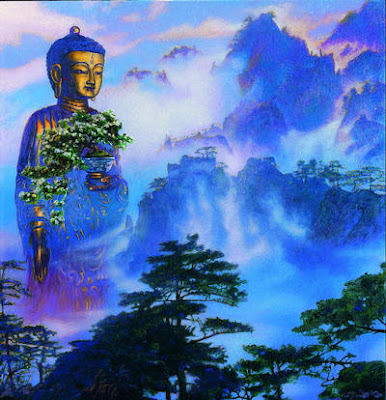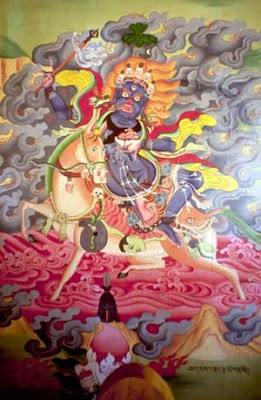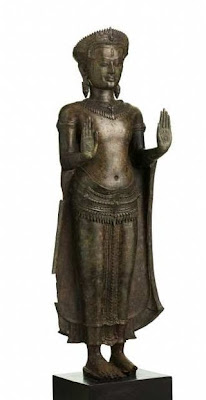3. “It is possible, brahmin, to describe gradual training, gradual practice, and gradual progress in this Doctrine and Discipline. Brahmin, just as when a clever horse-trainer obtains a fine thoroughbred colt, he first makes him get used to wearing the bit, and afterwards trains him further, so when the
Tathāgata [the Buddha himself] obtains a person to be tamed [trained full-time as a temporary or permanent monastic] he first disciplines that person thus: ‘Come, trainee, be virtuous, restrained with the restraint of the
disciplinary rules [the Path-to-
Moksha,
explained in detail here], be perfect in conduct and resort, and seeing fear even in the slightest fault, train by undertaking the training precepts.’
[Virtue]
4. “When, brahmin, the trainee is virtuous...and seeing fear even in the slightest fault, trains by undertaking the training precepts, then the Tathāgata disciplines that person further: ‘Come, trainee, guard the doors of your sense faculties. On seeing a form with the eye, do not grasp at its signs and features. If you were to leave the eye faculty unguarded, unskillful unwholesome states of covetousness and grief might invade you. Instead, practice the way of its restraint, guard the eye faculty, undertake the restraint of the eye faculty. On hearing a sound... On smelling an odor... On tasting a flavor... On touching a tangible with the body... On cognizing a mind-object with the mind, do not grasp at its signs and features. If you were to leave the mind faculty unguarded, unskillful unwholesome states of covetousness and grief might invade you. Instead, practice the way of its restraint, guard the mind faculty, undertake the restraint of the mind faculty.’
5. “When, brahmin, the trainee guards the doors of his sense faculties, then the Tathāgata disciplines that person further: ‘Come, trainee, be moderate in eating. Reflecting wisely, you should take food neither for amusement nor for intoxication nor for the sake of physical beauty, but only for the endurance and continuance of this body, for ending discomfort, and for assisting the supreme life [aimed at liberation], considering: ‘By eating I will terminate feelings of hunger without arousing new feelings of greed, and I will be healthy, blameless, and live in comfort.’”
[Mindful and Clearly Aware]
6. “When, brahmin, the trainee is moderate in eating, then the Tathāgata disciplines that person further: ‘Come, trainee, be devoted to wakefulness [alert, mindful, conscientious, and aware of what one is doing]. During the day, while walking back and forth and sitting, purify your mind of obstructive states. In the first watch of the night, while walking back and forth and sitting, purify your mind of obstructive states. In the middle watch of the night you should lie down on the right side in the lion’s posture [as when the Buddha passed into nirvana] with one foot overlapping the other, mindful and fully aware, after noting in your mind the time for rising. After rising, in the third watch of the night, while walking back and forth and sitting, purify your mind of obstructive states.’
7. “When, brahmin, the trainee is devoted to wakefulness, then the Tathāgata disciplines that person further: ‘Come, trainee, be possessed of mindfulness and full awareness [sati-sampajanna]. Act in full awareness when going and returning... when looking ahead and looking away... when flexing and extending your limbs... when wearing your robes and carrying your outer robe and bowl... when defecating and urinating... when walking, standing, sitting, falling asleep, waking up, talking, and keeping silent.’
8. “When, brahmin, the trainee possesses mindfulness and full awareness, then the Tathāgata disciplines that person further: ‘Come, trainee, resort to a secluded resting place: the forest, the root of a tree, a mountain, a ravine, a hillside cave, a charnel ground, a jungle thicket, an open space, a heap of straw.’

[Retreating into Seclusion]
9. “The trainee resorts to a secluded resting place: the forest... a heap of straw. On returning from almsround and eating, one sits down, folding legs crosswise, setting the body erect, and establishing mindfulness in front of one. Abandoning covetousness for the world, one abides with a mind free of covetousness, purifies the mind of covetousness. Abandoning ill will and hatred, one abides with a mind free of ill will, compassionate for the welfare of all living beings; one purifies the mind from ill will and hatred. Abandoning sloth and torpor, one abides free of sloth and torpor, perceiving light, mindful and fully aware; one purifies the mind of sloth and torpor. Abandoning restlessness and remorse, one abides unagitated with a mind inwardly peaceful; one purifies the mind of restlessness and remorse. Abandoning doubt, one abides having gone beyond doubt, unperplexed about wholesome states; one purifies the mind of doubt.
[Reaching Absorption (Zen)]
10. “Having thus abandoned these Five Hindrances, imperfections of the mind that weaken insight, quite secluded [and withdrawn] from sensual pleasures, secluded from unwholesome states of mind [related to lust, aversion, delusion, fear], one enters upon and abides in the first meditative absorption (jhāna, dhyana, zen), which is accompanied by applied and sustained attention, with rapture and pleasure born of seclusion [from sensual pleasures and mental distractions; seclusion is both physical and mental, although the mental is much more important]. With the stilling of applied and sustained attention, one enters upon and abides in the second meditative absorption (jhāna), which has self-confidence and singleness of mind without applied and sustained attention, with rapture and pleasure born of concentration. With the fading away as well of rapture, one abides in equanimity, and mindful and fully aware, still feeling pleasure with the body [piti is called "rapture" because it is literally pleasurable], one enters upon and abides in the third meditative absorption, on account of which noble ones say: ‘One indeed has a pleasant abiding who has equanimity and is mindful.’ Surpassing both pleasure and pain, and with the previous abandoning of joy and grief, one enters upon and abides in the fourth meditative absorption, which has neither-pain-nor-pleasure and purity of mindfulness due to equanimity.
[Reaching Enlightenment]
11. “This is my instruction, brahmin, to those trainees who are in the higher training, whose minds have not yet attained the goal [glimpsing nirvana, enlightenment], who abide aspiring to the supreme security from bondage [nirvana]. But these things conduce both to a pleasant abiding here and now and to mindfulness and full awareness for those trainees who [have gone beyond training and] are saints with taints destroyed, who have lived the supreme life, done what there was to be done, laid down the burden, reached their own goal, destroyed the fetters of becoming, and are completely liberated through final knowledge [insight, full enlightenment].”
[Attaining Nirvana]
12. When this was said, the brahmin Gaṇaka Moggallāna asked the Buddha: “When Master Gautama’s disciples are thus advised and instructed by him, do they all attain nirvana (Pali, nibbāna), the ultimate goal, or do some not attain it?” “When, brahmin, they are thus advised and instructed by me, some of my disciples attain nirvana, the ultimate goal, and some do not attain it.”
13. “Master Gautama, since nirvana exists and the path leading to nirvana exists and Master Gautama is present as the guide, what it the cause and reason why, when Master Gautama’s disciples are thus advised and instructed by him, some of them attain nirvana, the ultimate goal, and some do not attain it?”
[The Road to Nirvana]
 14. “In answer, brahmin, I will ask you a question, and you answer it as you see fit. Brahmin, are you familiar with the road leading to Rājagaha? [the famous capital of Magadha, where the Buddha spent a great deal of time].” “Yes, Master Gautama.” “Brahmin, suppose a man came who wanted to go to Rājagaha, and he approached you and said: ‘Venerable sir, I want to go to Rājagaha. Show me the road to Rājagaha.’ Then you told him: ‘Now, good man, this road goes to Rājagaha. Follow it for awhile and you will see a certain village, go a little further and you will see a certain town, go a little further and you will see Rājagaha with its lovely parks, groves, meadows, and ponds.’ Then, having been thus advised and instructed by you, he would take a wrong road and would go to the west. Then a second man came who wanted to go to Rājagaha, and he approached you and said: ‘Venerable sir, I want to go to Rājagaha. Show me the road to Rājagaha.’ Then you told him: ‘Now, good man, this road goes to Rājagaha. Follow it for awhile...and you will see Rājagaha with its lovely parks, groves, meadows, and ponds.’ Then, having been thus advised and instructed by you, he would arrive safely in Rājagaha. Now, brahmin, since Rājagaha exists, and the path leading to Rājagaha exists, and you are present as the guide, what is the cause, what is the reason why, when those men have been thus advised and instructed by you, one man takes a wrong road and goes to the west and one arrives safely in Rājagaha?” “What can I do about that, Master Gautama? I am one who shows the way.” “So too, brahmin, nirvana exists, and the path leading to nirvana exists, and I am present as the guide. Yet when my disciples have been thus advised and instructed by me, some of them attain nirvana, the ultimate goal, and some do not attain it. What can I do about that, brahmin? The Tathāgata is one who shows the way.”
14. “In answer, brahmin, I will ask you a question, and you answer it as you see fit. Brahmin, are you familiar with the road leading to Rājagaha? [the famous capital of Magadha, where the Buddha spent a great deal of time].” “Yes, Master Gautama.” “Brahmin, suppose a man came who wanted to go to Rājagaha, and he approached you and said: ‘Venerable sir, I want to go to Rājagaha. Show me the road to Rājagaha.’ Then you told him: ‘Now, good man, this road goes to Rājagaha. Follow it for awhile and you will see a certain village, go a little further and you will see a certain town, go a little further and you will see Rājagaha with its lovely parks, groves, meadows, and ponds.’ Then, having been thus advised and instructed by you, he would take a wrong road and would go to the west. Then a second man came who wanted to go to Rājagaha, and he approached you and said: ‘Venerable sir, I want to go to Rājagaha. Show me the road to Rājagaha.’ Then you told him: ‘Now, good man, this road goes to Rājagaha. Follow it for awhile...and you will see Rājagaha with its lovely parks, groves, meadows, and ponds.’ Then, having been thus advised and instructed by you, he would arrive safely in Rājagaha. Now, brahmin, since Rājagaha exists, and the path leading to Rājagaha exists, and you are present as the guide, what is the cause, what is the reason why, when those men have been thus advised and instructed by you, one man takes a wrong road and goes to the west and one arrives safely in Rājagaha?” “What can I do about that, Master Gautama? I am one who shows the way.” “So too, brahmin, nirvana exists, and the path leading to nirvana exists, and I am present as the guide. Yet when my disciples have been thus advised and instructed by me, some of them attain nirvana, the ultimate goal, and some do not attain it. What can I do about that, brahmin? The Tathāgata is one who shows the way.”
[NOTE: Just as the Dharma points to the Truth and is itself true but not the Truth it points to, so those on the Path must never confuse religion or tradition with the final Truth of liberation, which is directly visible here and now in this very life for those who practice the training but not for those who merely study it.]
[Who strays?]
15. When this was said, the brahmin Gaṇaka Moggallāna said to the Buddha: “There are persons who are faithless and have gone forth from the home life into the left-home life not out of confidence but seeking an easy livelihood, who are fraudulent, deceitful, treacherous, haughty, hollow, personally vain, rough-tongued, loose-spoken, unguarded in their sense faculties, immoderate in eating, undevoted to wakefulness, unconcerned with recluseship, not greatly respectful of training, luxurious, careless, leaders in backsliding, neglectful of seclusion, lazy, wanting in energy, unmindful, not fully aware, unconcentrated, with straying minds, devoid of wisdom, drivellers. Master Gautama does not dwell together with these. “But there are others who have gone forth out of confidence [in the Buddha, Dharma, or Sangha] from the home life into the left-home life, who are ethical, honest, conscientious, humble, sturdy, above board, tactful, and careful in speech; who are guarded in their sense faculties, moderate in eating, devoted to wakefulness, concerned with recluseship, greatly respectful of training, frugal and careful, who are keen to avoid backsliding, leaders in seclusion, energetic, resolute, established in mindfulness, fully aware, concentrated, with unified minds, possessing wisdom, not drivellers. Master Gautama dwells together with these.
16. “Just as black orris root is reckoned the best of root perfumes, red sandalwood the best of wood perfumes, and jasmine the best of flower perfumes, so too, Master Gautama’s advice is supreme among the teachings of today.
17. “Magnificent, Master Gautama! Magnificent, Master Gautama! Master Gautama has made the Doctrine (Dharma) clear in many ways, as though he were turning upright what had been overturned, revealing what was hidden, showing the way to one who was lost, or holding up a lamp in the dark for those with eyesight to see forms. I go to Master Gautama for guidance (sarana) and to the Dharma [the truth revealed by the Buddha] and to the Sangha of [heedful and accomplished] trainees. Let Master Gautama remember me as a lay follower who has gone to him for guidance for life.”
Original translation: PaliCanon.org; alternative translations at DhammaWeb.net and AccessToInsight.org
 Unseasonal cold and heavy rains have swept through the south of the country.
Unseasonal cold and heavy rains have swept through the south of the country.  THAILAND (BBC) - Flooding across the south of Thailand has killed at least 11 people and stranded thousands of tourists. See pictures (Thailand floods).
THAILAND (BBC) - Flooding across the south of Thailand has killed at least 11 people and stranded thousands of tourists. See pictures (Thailand floods). 

































































































































































































































































